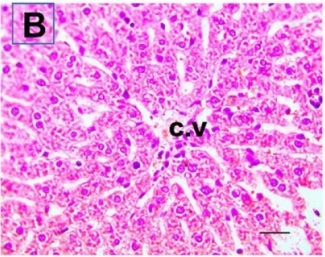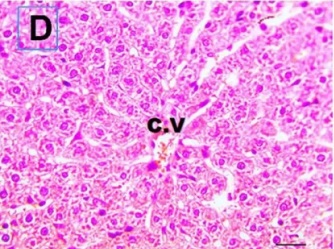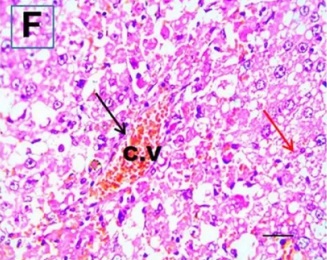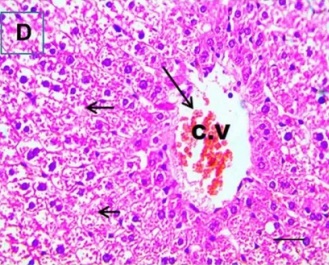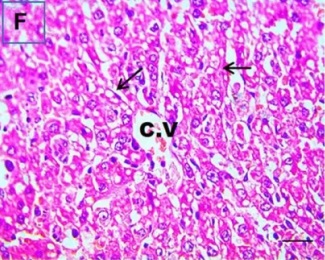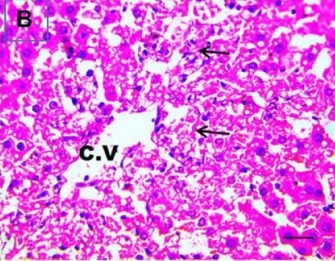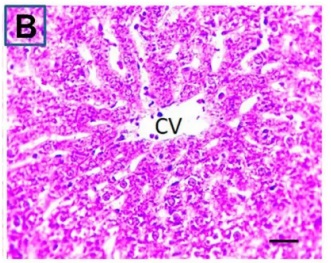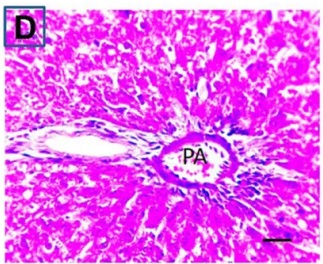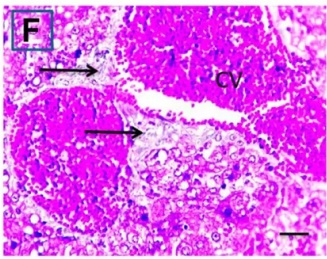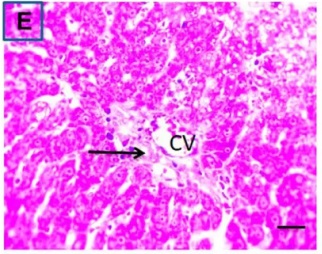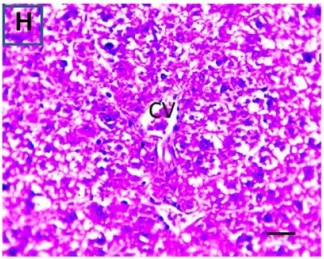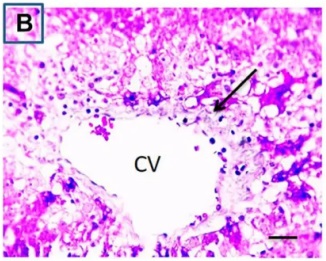
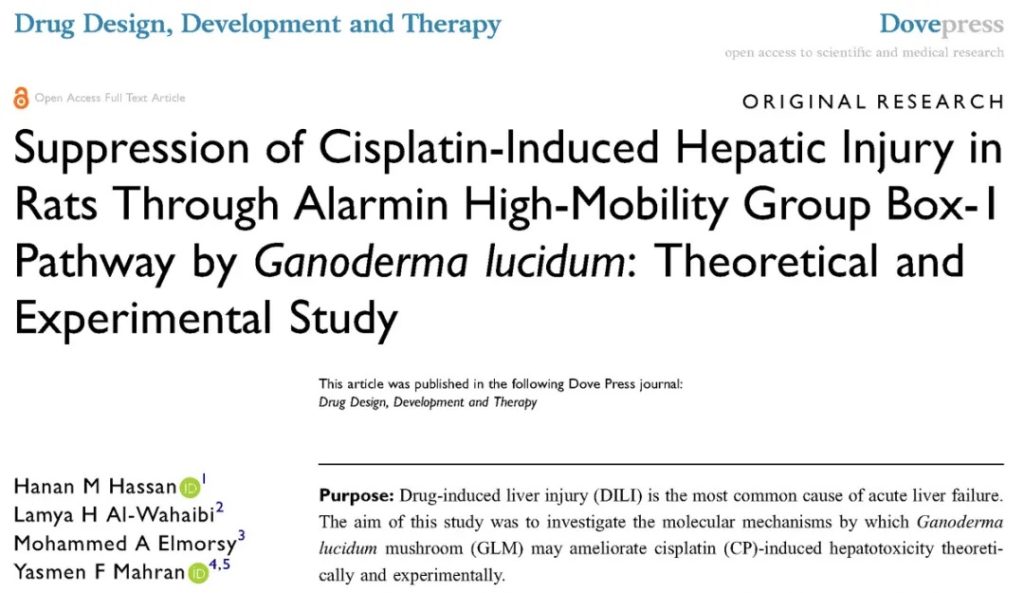
Chemotherapy injures the liver and kidneys while Lingzhi (aussi appeléGanoderma lucidum ou champignon Reishi) protects the liver and kidneys.
PeutGanoderma lucidum withstand the liver and kidney damage caused by chemotherapy?
A team composed of Professor Hanan M Hassan from the Faculty of Pharmacy of Delta University for Science & Technology in Egypt and Professor Yasmen F Mahran from the Faculty of Pharmacy of Ain Shams University in Egypt used cisplatin, the most common traditional chemotherapy drug, to test the possibility ofGanoderma lucidum in protecting liver and kidney cells from cisplatin injury.
Their research results are divided into two articles: one is protecting the liver while another is protecting the kidneys. They were published in “Drug Design, Development and Therapy” and “Oxidative Medicine and Cellular Longevity” in June and July 2020, respectivement.
The anti-oxidant, anti-inflammatory and anti-apoptotic effects ofGanoderma lucidum can obviously block many oxidative damage, inflammatory damage and cell apoptosis induced by cisplatin, and such protection is applicable to liver cells or kidney cells. This not only highlights the dual medicinal value ofGanoderma lucidum but also provides a feasible auxiliary protection method for cancer chemotherapy.
In order to avoid making this article too long, the author will introduce the role ofGanoderma lucidum in this aspect in two parts in the hope that these scientifically based data and evidence will bring more confidence to friends who seek to reduce the side effects of chemotherapy.
Part 1Ganoderma lucidum protège le foie contre. cisplatin hepatotoxicity
The researchers compared the differences between using and not usingGanoderma lucidum during cisplatin treatment in six groups of healthy rats and the differences in protection against liver injury with differentGanoderma lucidum administration methods. They are:
◆Groupe de contrôle (Suite): le groupe qui ne reçoit aucun traitement;
◆Ganoderma lucidum Groupe(GL): le groupe à qui on n'injecte pas de cisplatine mais qui mangeGanoderma lucidum tous les jours;
◆Groupe cisplatine(CP): le groupe à qui on injecte uniquement du cisplatine mais qui ne mange pasGanoderma lucidum;
◆Groupe quotidien (Tous les jours): le groupe à qui on injecte du cisplatine et qui mangeGanoderma lucidum tous les jours;
◆Groupe tous les deux jours (NEM): le groupe à qui on injecte du cisplatine et qui mangeGanoderma lucidum tous les deux jours;
◆Groupe intrapéritonéal (i.p.): le groupe qui reçoit une injection de cisplatine et reçoit une injection intrapéritonéale deGanodermie lucide.
Tous ceux qui ont reçu du cisplatine ont reçu une injection intrapéritonéale de 12 mg/kg of Cisplatin on the first day of the experiment to trigger acute liver injury; ceux qui ont reçu l'injection intrapéritonéale deGanoderma lucidum ont été injectés une fois les deuxième et sixième jours de l'expérience.
LeGanoderma lucidum used in the experiment contains active ingredients such as triterpenes, stérols, polysaccharides, polyphénols et flavonoïdes. LeGanoderma lucidum given in animal experiments, whether it is taken orally or by injection, is calculated at a daily dose of 500 mg/kg.
(1) Ganoderma lucidum reduces hepatocellular injury
Après 10 jours, it can be seen that cisplatin will increase the hepatitis index and total bilirubin level in the rat’s serum. These are all signs of hepatocellular injury. But ifGanoderma lucidum is involved at the same time, the increased value can be reduced a lot (Chiffre 1).
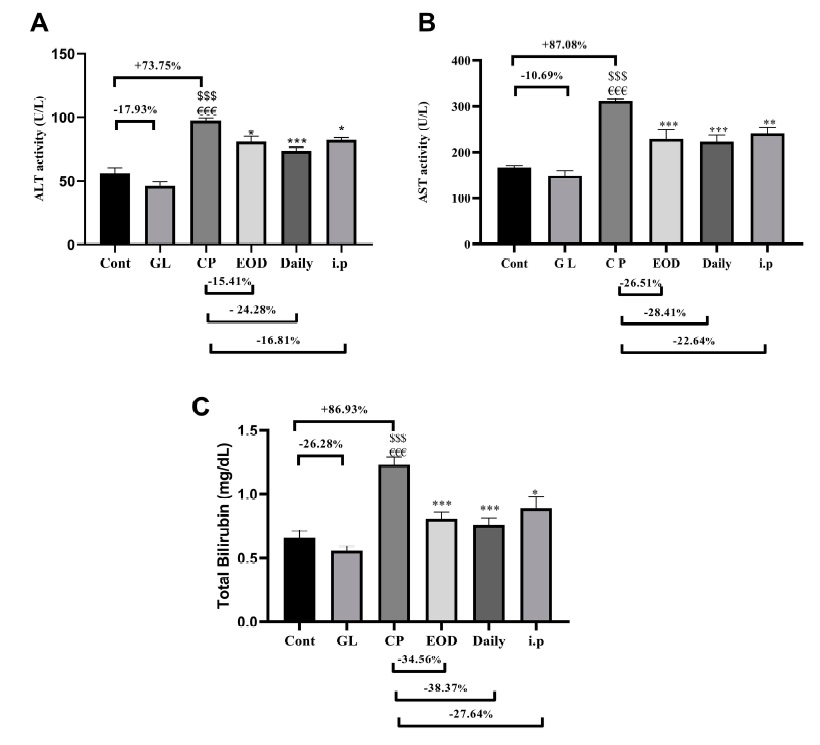
Data Source/Drug Des Devel Ther. 2020; 14:2335-2353.
Chiffre 1 Effets du cisplatine etGanoderma lucidum on liver injury indicators
Put the liver tissue section under a microscope, and you can see that cisplatin can cause liver congestion (the blood that should return to the heart is blocked and stagnates in the hepatic veins), cell degeneration (vacuoles appear, which is the earliest change in cellular injury), apoptosis and necrosis, but these conditions can also be alleviated by usingGanoderma lucidum.
Chiffre 2 Effets du cisplatine etGanoderma lucidum on hepatocytes
(2)Ganoderma lucidum enhances the antioxidant capacity of liver cells
This article further compares the oxidative damage suffered by each group of liver tissues. There are two observation indicators: MDA(malondialdéhyde), a product formed after the destruction of cell membranes by free radicals, and H2O2 (hydrogen peroxide), an intermediate product formed after the metabolism of free radicals by antioxidant enzymes.
Both of these products have the oxidative properties of free radicals and must be further treated before they can be truly “detoxified”, so the amount of them can tell us the oxidative damage that the liver tissue “has suffered” and “will suffer”.
Évidemment, cisplatin will cause great oxidative damage to liver tissue, but ifGanoderma lucidum is involved In treatment at the same time, such damage can be reduced (Chiffre 3).
Because the changes in the concentration of antioxidant enzymes (SOD and GSH) in the liver tissues of each group and the changes in oxidative damage indicators showed a completely opposite trend, it can be inferred thatGanoderma lucidumwill increase the antioxidant capacity of liver tissue and reduce the damage by “increasing antioxidant enzymes”.
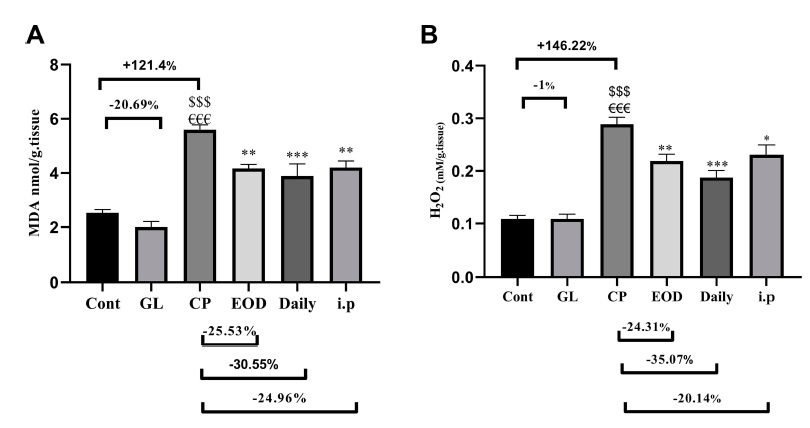
Figure 3 Effects of cisplatin andGanoderma lucidum on oxidative damage of liver tissue
(3)Ganoderma lucidum enhances the anti-inflammatory ability of liver cells
Cisplatin threatens the survival of cells by damaging DNA and inducing a large number of free radicals; cells under pressure will turn on the master switch NF-kB that regulates the inflammation response, prompting cells to synthesize and release tumor necrosis factor (TNF-α) and other cytokines to activate the first wave of inflammatory reactions and sound the alarm for immunity.
Immediately afterwards, those cells killed by oxidative damage or inflammation will release another cytokine, HMGB-1, to activate more immune cells, triggering waves of inflammation.
Continuous inflammation will not only, à son tour, intensify oxidative damage but also drive more cells to death, and even cause liver tissue to gradually develop fibrosis during the process of repeated inflammation and repair.
Heureusement, just likeGanoderma lucidum can reduce the oxidative damage caused by cisplatin, animal experiments also confirmed that the combined use of cisplatin andGanoderma lucidum can inhibit the activation of the inflammation switch NF-kB, reduce the inflammation-promoting TNF-α and HMGB-1, and increase the anti-inflammatory cytokine IL-10 in the tissues of the liver at the same time (Chiffre 4).
Taken together, these effects not only inhibit inflammation but also reduce collagen deposition and prevent the progression of liver fibrosis (Chiffre 5).
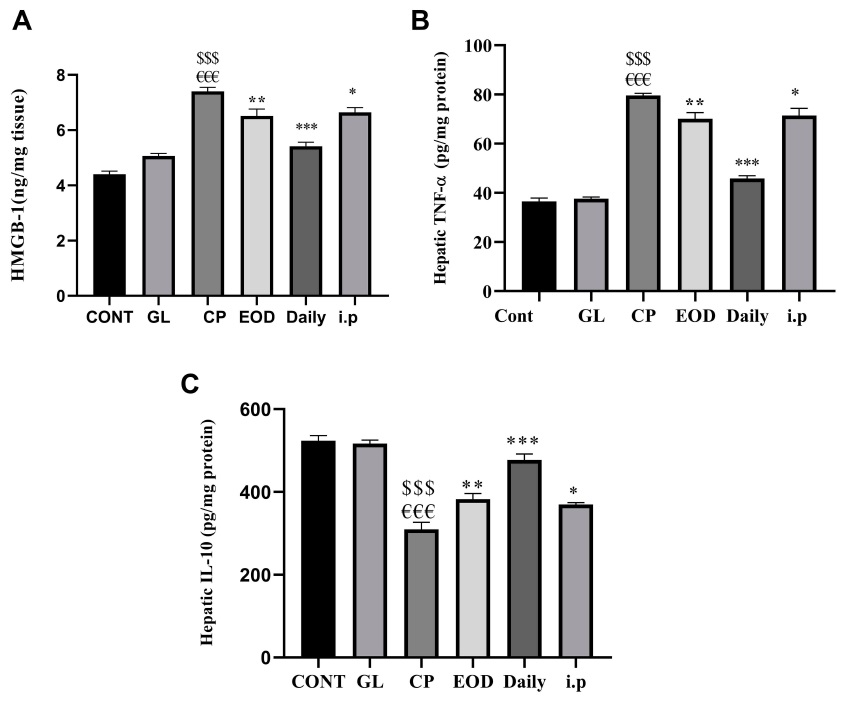
Data Source/Drug Des Devel Ther. 2020; 14: 2335-2353.
Chiffre 4 Effets du cisplatine etGanoderma lucidum on inflammation of liver tissue
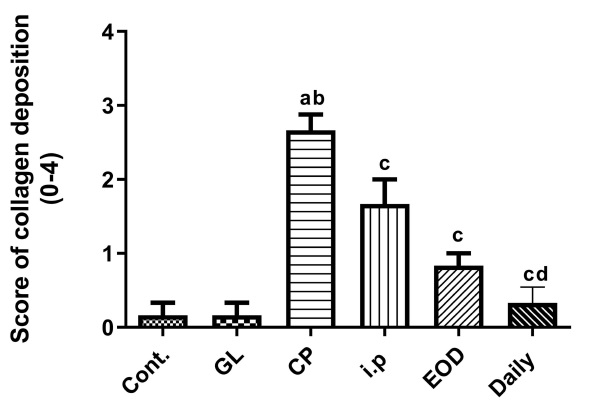
Data Source/Drug Des Devel Ther. 2020; 14: 2335-2353.
Chiffre 5 Effects of cisplatin and Ganoderma lucidum on liver fibrosis
(4)Ganoderma lucidum enhances the anti-apoptotic ability of liver cells
Whether through oxidative damage or inflammatory damage, cisplatin will eventually activate the “apoptosis” mechanism and force liver cells to die.
Autrement dit, if liver cells can hold the last line of defense, they will have more chances to survive and reduce the severity of liver damage.
There are many protein molecules that regulate apoptosis. Parmi eux, the most representative ones are: p53, which can promote apoptosis, Bcl-2, which can inhibit apoptosis, and caspase-3, which executes apoptosis at the last minute.
According to the researchers’ analysis of liver tissues of experimental animals in each group, Ganoderma lucidum can not only promote the expression of Bcl-2 but also inhibit the expression of p53 and caspase-3, which can provide powerful anti-apoptotic energy for liver cells.
(5) Ganoderic acids play an important anti-inflammatory role
From anti-oxidation, anti-inflammatoire, anti-apoptosis to the actual performance of reducing liver damage, the researchers have compiled the mechanism ofGanoderma lucidum in inhibiting cisplatin hepatotoxicity into the following diagram for your reference.
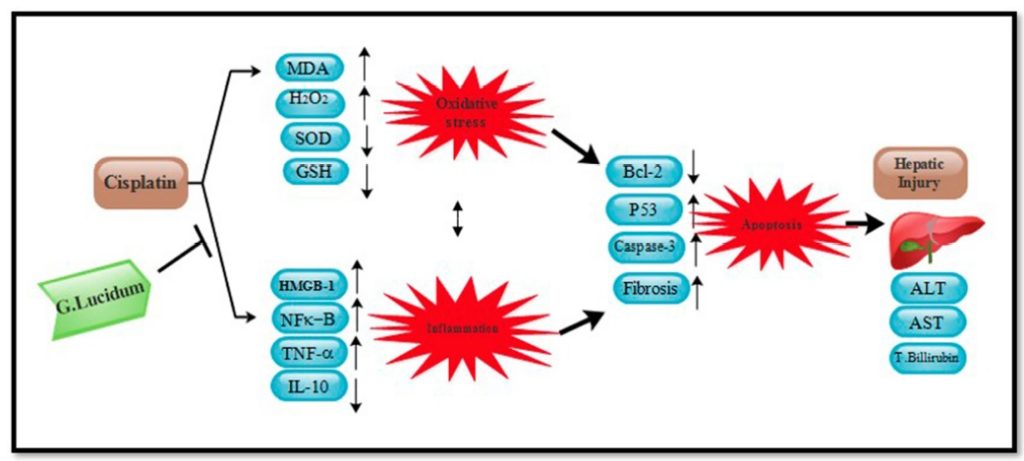
Data Source/Drug Des Devel Ther. 2020; 14: 2335-2353.
Chiffre 6 The mechanism of Ganoderma lucidum in inhibiting liver toxicity of cisplatin
In the end of this study, the analysis of the “molecular docking simulation system” found that at least 14 ganoderic acids in the triterpenes ofGanoderma lucidum (as shown in the table below) can directly and effectively bind to the key cytokine HMGB-1, thus inactivating the pro-inflammatory activity of HMGB-1.
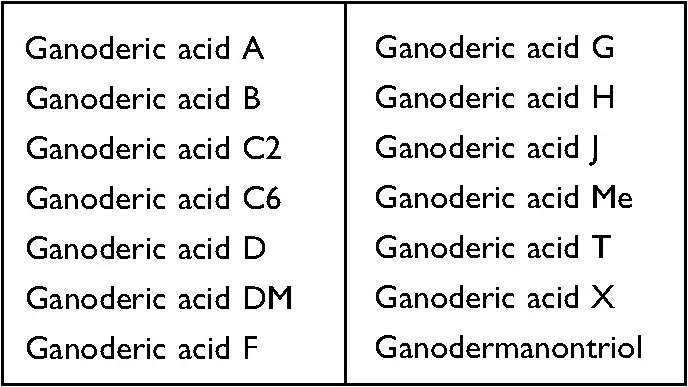
Since anti-inflammation is one of the important mechanisms ofGanoderma lucidum to reduce Cisplatin-induced hepatotoxicity, “richness in Ganoderic acid” has become an indicator component ofGanoderma lucidum to protect the liver.
What kind ofGanoderma lucidum ingredients can contain such abundant Ganoderic acids? According to past research, it is known that they are mainly present in the “Ganoderma lucidum fruiting body alcohol extract”.
It is worth mentioning that the rats in theGanoderma lucidum group that only ateGanoderma lucidum are almost the same as the rats in the control group in the above-mentioned experimental results, indiquant queGanoderma lucidum is highly safe for consumption.
En outre, the method of usingGanoderma lucidum is also very important. If you are willing to review the chart shown in this article, it is not difficult to find that “Every Day Group” has the best effect.
En fait, Every Day Group has the best effect in reducing the hepatic and renal toxicity of cisplatin in animal experiments,which is different from otherGanodermie lucidum groupes.
What are the specific manifestations of the above-mentioned good effects? Stay tuned for “Part 2Ganoderma lucidum protège le rein vs. Néphrotoxicité du cisplatine ».
[Source de données]
1.Hanan M Hassan, et autres. Suppression des lésions hépatiques induites par le cisplatine chez le rat via la voie Box-1 du groupe à haute mobilité Alarmin parGanoderma lucidum: Etude théorique et expérimentale. Drug Des Devel Ther. 2020;14: 2335-2353.
2.Yasmen F Mahran, et coll.Ganoderma lucidum Prévient la néphrotoxicité induite par le cisplatine grâce à l'inhibition de la signalisation des récepteurs du facteur de croissance épidermique et à l'apoptose médiée par l'autophagie. Oxyde avec cellule Longev. 2020. est-ce que je: 10.1155/2020/4932587.
FIN
À propos de l'auteur/Mme. Wu Tingyao
Wu Tingyao a fait un reportage de première mainGanoderma lucidum informations depuis 1999. Elle est l'auteur deGuérir avec Ganoderma (publié dans The People's Medical Publishing House en avril 2017).
★ Cet article est publié sous l'autorisation exclusive de l'auteur, et la propriété appartient à GANOHERB
★ Les œuvres ci-dessus ne peuvent pas être reproduites, extrait ou utilisé d'une autre manière sans l'autorisation de GanoHerb
★ Si l'utilisation des œuvres a été autorisée, ils doivent être utilisés dans le cadre de l'autorisation et indiquer la source: GanoHerbe
★ Violation de la déclaration ci-dessus, GanoHerb poursuivra ses responsabilités juridiques connexes
★ Le texte original de cet article a été rédigé en chinois par Wu Tingyao et traduit en anglais par Alfred Liu.. S'il y a une divergence entre la traduction (Anglais) et l'original (Chinois), le chinois original prévaudra. Si les lecteurs ont des questions, veuillez contacter l'auteur original, MS. Wu Tingyao.
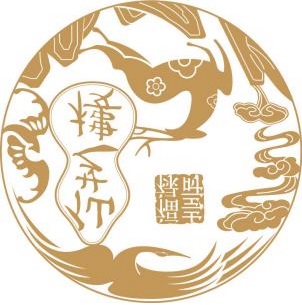
Transmettez la culture de santé millénaire
Contribuer au bien-être pour tous


